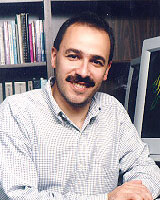 | |||||||||||||||
 |
 |
 |
 |
 |
 |
 |
 |
 |
 |
 |
 |
 |
 |
 |
 |
CSB Core Faculty
- Ray Blind
- Tony Capra
- Walter Chazin
- Steven Damo
- Jamaine Davis
- Martin Egli
- Brandt Eichman
- Steve Fesik
- Tina Iverson
- Lauren Jackson
- Erkan Karakas
- Brett Kroncke
- Borden Lacy
- Galina Lepesheva
- Carlos Lopez
- Terry Lybrand
- Hassane Mchaourab
- Jens Meiler
- Terunaga Nakagawa
- Yi Ren
- Chuck Sanders
- Ben Spiller
- Michael Stone
Emeritus:
- Al Beth
- Paul Bock
- Gerald Stubbs
- Michael Waterman
Hassane Mchaourab
Spectroscopic and biochemical studies of protein structure and functional dynamics
 A
central goal of protein biophysics is to understand the relation between the
sequence of proteins and their three dimensional structure, the sequence-fold
specificity, and how the structure and its conformational dynamics confer function.
This understanding is critical to de novo protein engineering where the goal
is to design novel protein switches and transducers for application in biotechnology
and material sciences. In the postgenomic era, this quest is being helped by
the wealth of information about a similar phenomenon namely "natural protein
engineering". The understanding of evolutionary histories and their use
to guide experimental biochemistry will necessarily revolutionize our understanding
of the relation between sequence, structure, function and dynamics. Current
research interests include the evolution of structure in the small heat-shock
protein superfamily and the functional mechanism of multidrug transporters
including an ABC transporter homologous to human p-glycoprotein, a protein
associated with resistance to chemotherapy in cancer treatment.
A
central goal of protein biophysics is to understand the relation between the
sequence of proteins and their three dimensional structure, the sequence-fold
specificity, and how the structure and its conformational dynamics confer function.
This understanding is critical to de novo protein engineering where the goal
is to design novel protein switches and transducers for application in biotechnology
and material sciences. In the postgenomic era, this quest is being helped by
the wealth of information about a similar phenomenon namely "natural protein
engineering". The understanding of evolutionary histories and their use
to guide experimental biochemistry will necessarily revolutionize our understanding
of the relation between sequence, structure, function and dynamics. Current
research interests include the evolution of structure in the small heat-shock
protein superfamily and the functional mechanism of multidrug transporters
including an ABC transporter homologous to human p-glycoprotein, a protein
associated with resistance to chemotherapy in cancer treatment.
Small heat-shock proteins, including the major protein component in the lens alpha-crystallin, are molecular chaperones that help other proteins avoid aggregation. Protein aggregation is associated with many pathogenic conditions including alzheimer's diseases, mad cow disease and cataract. Our laboratory has pionnered novel assay to understand the mechanisms of both inherited and age-relted cataract.We investigate small heat-shock proteins from various organisms across the evolutionary spectrum.
Active drug extrusion by multidrug transporters is one of four general mechanisms associated with the multidrug resistance phenomenon, a key problem in the treatment of bacterial and fungal infections and cancers. The overexpression of adenosine triphosphate binding cassette (ABC) transporters is the most frequent cause of resistance to cytotoxic agents. In addition, mutations in the genes encoding the 48 human ABC transporters are associated with diseases such as cystic fibrosis, Tangier disease and adrenoleukodystrophy. Our laboratory is investigating how these transporters work, a key step in the design of therapeutic strategies.
Because many questions, both of structural and dynamic nature, cannot be answered with current physical techniques, we have been actively developing alternative structural methods based on paramagnetic and fluorescent reporter groups, taking advantage of the ability to site-specifically incorporate these groups into protein sequences.
|
VU Home |
VUMC Home |
People Finder |
University Calendar
webmaster- modified on July 03, 2018 |